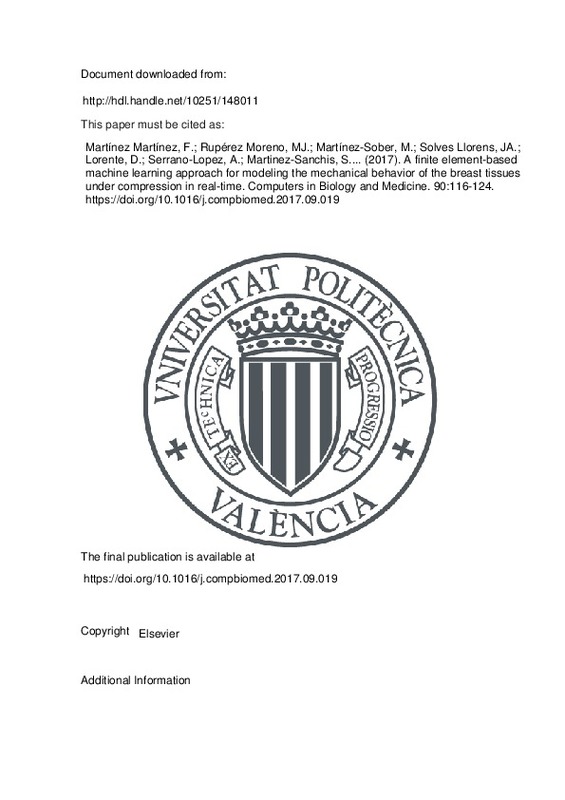JavaScript is disabled for your browser. Some features of this site may not work without it.
Buscar en RiuNet
Listar
Mi cuenta
Estadísticas
Ayuda RiuNet
Admin. UPV
A finite element-based machine learning approach for modeling the mechanical behavior of the breast tissues under compression in real-time
Mostrar el registro sencillo del ítem
Ficheros en el ítem
| dc.contributor.author | Martínez Martínez, Francisco
|
es_ES |
| dc.contributor.author | Rupérez Moreno, María José
|
es_ES |
| dc.contributor.author | Martínez-Sober, M.
|
es_ES |
| dc.contributor.author | Solves Llorens, Juan Antonio
|
es_ES |
| dc.contributor.author | Lorente, D.
|
es_ES |
| dc.contributor.author | Serrano-Lopez, A.J.
|
es_ES |
| dc.contributor.author | Martinez-Sanchis, Sandra
|
es_ES |
| dc.contributor.author | Monserrat, C.
|
es_ES |
| dc.contributor.author | Martin-Guerrero, J.D.
|
es_ES |
| dc.date.accessioned | 2020-07-15T03:32:41Z | |
| dc.date.available | 2020-07-15T03:32:41Z | |
| dc.date.issued | 2017-11-01 | es_ES |
| dc.identifier.issn | 0010-4825 | es_ES |
| dc.identifier.uri | http://hdl.handle.net/10251/148011 | |
| dc.description.abstract | [EN] This work presents a data-driven method to simulate, in real-time, the biomechanical behavior of the breast tissues in some image-guided interventions such as biopsies or radiotherapy dose delivery as well as to speed up multimodal registration algorithms. Ten real breasts were used for this work. Their deformation due to the displacement of two compression plates was simulated off-line using the finite element (FE) method. Three machine learning models were trained with the data from those simulations. Then, they were used to predict in real-time the deformation of the breast tissues during the compression. The models were a decision tree and two tree-based ensemble methods (extremely randomized trees and random forest). Two different experimental setups were designed to validate and study the performance of these models under different conditions. The mean 3D Euclidean distance between nodes predicted by the models and those extracted from the FE simulations was calculated to assess the performance of the models in the validation set. The experiments proved that extremely randomized trees performed better than the other two models. The mean error committed by the three models in the prediction of the nodal displacements was under 2 man, a threshold usually set for clinical applications. The time needed for breast compression prediction is sufficiently short to allow its use in real-time (< 0.2 s). | es_ES |
| dc.description.sponsorship | This work has been funded by the Spanish Ministry of Economy and Competitiveness (MINECO) through research projects TIN2014-52033-R and DPI2013-40859-R with the support of European FEDER funds. | es_ES |
| dc.language | Inglés | es_ES |
| dc.publisher | Elsevier | es_ES |
| dc.relation.ispartof | Computers in Biology and Medicine | es_ES |
| dc.rights | Reserva de todos los derechos | es_ES |
| dc.subject | Breast biomechanics | es_ES |
| dc.subject | Finite element methods | es_ES |
| dc.subject | Machine learning | es_ES |
| dc.subject | Modeling | es_ES |
| dc.subject | Breast compression | es_ES |
| dc.subject.classification | INGENIERIA MECANICA | es_ES |
| dc.subject.classification | LENGUAJES Y SISTEMAS INFORMATICOS | es_ES |
| dc.title | A finite element-based machine learning approach for modeling the mechanical behavior of the breast tissues under compression in real-time | es_ES |
| dc.type | Artículo | es_ES |
| dc.identifier.doi | 10.1016/j.compbiomed.2017.09.019 | es_ES |
| dc.relation.projectID | info:eu-repo/grantAgreement/MINECO//TIN2014-52033-R/ES/SIMULACION DEL COMPORTAMIENTO BIOMECANICO DEL TEJIDO BLANDO EN TIEMPO REAL MEDIANTE INTELIGENCIA COMPUTACIONAL/ | es_ES |
| dc.relation.projectID | info:eu-repo/grantAgreement/MINECO//DPI2013-40859-R/ES/SISTEMA DE SEGUIMIENTO DE LESIONES TUMORALES HEPATICAS MEDIANTE APROXIMACIONES BIOMECANICAS PARA DIAGNOSIS TEMPRANA Y PLANIFICACION DE TRATAMIENTO./ | es_ES |
| dc.rights.accessRights | Abierto | es_ES |
| dc.contributor.affiliation | Universitat Politècnica de València. Departamento de Sistemas Informáticos y Computación - Departament de Sistemes Informàtics i Computació | es_ES |
| dc.contributor.affiliation | Universitat Politècnica de València. Departamento de Ingeniería Mecánica y de Materiales - Departament d'Enginyeria Mecànica i de Materials | es_ES |
| dc.description.bibliographicCitation | Martínez Martínez, F.; Rupérez Moreno, MJ.; Martínez-Sober, M.; Solves Llorens, JA.; Lorente, D.; Serrano-Lopez, A.; Martinez-Sanchis, S.... (2017). A finite element-based machine learning approach for modeling the mechanical behavior of the breast tissues under compression in real-time. Computers in Biology and Medicine. 90:116-124. https://doi.org/10.1016/j.compbiomed.2017.09.019 | es_ES |
| dc.description.accrualMethod | S | es_ES |
| dc.relation.publisherversion | https://doi.org/10.1016/j.compbiomed.2017.09.019 | es_ES |
| dc.description.upvformatpinicio | 116 | es_ES |
| dc.description.upvformatpfin | 124 | es_ES |
| dc.type.version | info:eu-repo/semantics/publishedVersion | es_ES |
| dc.description.volume | 90 | es_ES |
| dc.identifier.pmid | 28982035 | es_ES |
| dc.relation.pasarela | S\344757 | es_ES |
| dc.contributor.funder | European Regional Development Fund | es_ES |
| dc.contributor.funder | Ministerio de Economía y Competitividad | es_ES |







![[Cerrado]](/themes/UPV/images/candado.png)

